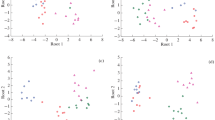Summary
Eleven patients with carcinoid tumours and increased serotonin synthesis have been studied. Ten patients had diarrhea, 9 patients had liver metastasis and 7 had cardiac failure. Seven patients had spontaneous flushings. Thus only 7 of 11 patients with a carcinoid tumour and increased urinary excretion of 5-hydroxyindoleacetic acid had a typical carcinoid syndrome with flushing, diarrhea and heart failure. In eight patients the primary tumour had arisen form the intestintal tract. In the remaining patients the tumour had its origin either from the bronchus, the stomach or the pancreas. In one patient no primary tumour was found. A flush could be induced by the injection of amines or bradykinin in all patients with spontaneous flush attacks. In 3 patients without spontaneous flushing no flushing could be provoked by the administration of amines or bradykinin. The amine-induced flushes gave the same subjective sensation to the patients as the spontaneous flushes. Only half of the patients felt the bradykinin induced flush in the same way as the spontaneous flush. Oral administration of phentolamine abolished the flush inducing effect of amine injections and decreased the number of spontaneous flush episodes. Eight patients have been treated with p-chlorophenylalanine (PCP) in a daily dosage of up to 3 g. The urinary excretion of 5-hydroxyindole acetic acid decreased in all patients during PCP treatment. In 3 patients with increased urinary excretion of 5-hydroxytryptophan PCP-administration resulted in a significant decrease of this amino acid. This indicates that PCP inhibits the tryptophane hydroxylase. No side effects have been observed during the PCP treatment which was performed for up to 120 days. The most striking effect of PCP was the diminution or abolition of the diarrhea in all patients treated.
Zusammenfassung
Von 11 Carcinoidpatienten mit vermehrter Serotonin-Synthese hatten 10 Patienten Diarrhöe, 9 Patienten nachweisbare Lebermetastasen und 7 Patienten zeigten eine Kardiopathie. Sieben Patienten hatten spontane Flushanfälle. Bei diesen Patienten konnte ein Flush auch durch intravenöse Injektion von Aminen oder Bradykinin hervorgerufen werden. Bei 3 Patienten ohne Spontanflush in der Anamnese konnte ein Flush durch Provokation nicht ausgelöst werden. Der durch Amine provozierte Flush wurde von allen Patienten als dem Spontanflush gleich empfunden. Nur die Hälfte der Patienten empfanden den Bradykinin induzierten Flush gleich dem Spontanflush. Regitinbehandlung verhindert den durch Amine provozierten Flush und verminderte die Anzahl der spontanen Flushanfälle.
Die Behandlung mit p-Chlorphenylalanin (PCP) in einer Dosierung bis zu 3 g täglich resultierte bei allen Patienten in einer Verminderung der 5-Hydroxyindolessigsäure-Ausscheidung und der Diarrhöe. Bei 3 Patienten mit vermehrter 5-Hydroxytryptophan-Ausscheidung wurde diese durch PCP vermindert, was darauf hindeutet, daß die Tryptophanhydroxylase durch PCP gehemmt wird. Die PCP-Behandlung, die bis zu einer Dauer von 120 Tagen durchgeführt wurde, zeigte bei den Patienten keine Nebenwirkungen.
Similar content being viewed by others
Literatur
Adamson, A. R., Grahame-Smith, D. G., Peart, W. S., Starr, M.: Pharmacological blockade of carcinoid flushing provoked by catecholamines and alcohol. Lancet1969 I, 293.
Aronsen, K. F., Steiner, H., Pihl, B., Studnitz, W. von: Surgical treatment of metastasizing carcinoid tumours. Acta chir. scand.135, 177 (1969).
—— Boquist, L., Falkmer, S., Hägerstrand, I., Steiner, H., Studnitz, W. von: Carcinoid syndrome and hyperinsulinism. Acta path. microbiol. scand.78A, 265 (1970).
Cremata, V. Y., Koe, B. K.: Clinical-pharmacological evaluation of p-chlorophenylalanine: new serotonin—depleting agent. Clin. Pharmacol. Ther.7, 768 (1966).
Engelman, K., Lovenberg, W., Sjoerdsma, A.: Inhibition of serotonin synthesis by para-chlorophenylalanine in patients with the carcinoid syndrome. New Engl. J. Med.277, 1103 (1967).
Hanson, A., Serin, F.: Determination of 5-hydroxyindole acetic acid in urine, and its excretion in patients with malignant carcinoids. Lancet1955II, 1359.
Jepson, J. B.: Paperchromatography of urinary indoles. Lancet1955II, 1009.
Jequier, E., Lovenberg, W., Sjoerdsma, A.: Tryptophan hydroxylase inhibition: mechanism by which p-chlorophenylalanine depletes rat brain serotonin. Molec. Pharmacol.3, 274 (1967).
Koe, B. K., Weissman, A.: p-Chlorophenylalanine: specific depletor of brain serotonin. J. Pharmacol. exp. Ther.154, 499 (1966).
Levine, R. J., Sjoerdsma, A.: Pressor amines and the carcinoid flush. Ann. intern. Med.58, 818 (1963).
Melmon, K. L., Lovenberg, W., Sjoerdsma, A.: Characteristics of carcinoid tumor kallikrein: Identification of lysylbradykin as a peptide it produces in vitro. Clin. chim. Acta12, 292 (1965).
Melmon, K., Sjoerdsam, A., Gillespie, L., Mason, D. T.: Release of a kinin peptide in carcinoid syndrome. Lancet1964I, 514.
Oates, J. A., Pettinger, W. A., Doctor, R. B.: Evidence for the release of bradykinin in carcinoid syndrome. J. clin. Invest.45, 173 (1966).
Sandler, M., Snow, P. J. D.: An atypical carcinoid tumour secreting 5-hydroxytryptophan. Lancet1958I, 137.
Sherry, S., Colman, S. W.: Observations on the plasma kallikreinogen (pre-kallikrein)—kallikrein enzyme system. Trans. Ass. Amer. Phycns.81, 40 (1969).
Studnitz, W. von, Waldenström, J., Mikulowski, P.: p-Chlorophenylalanine in carcinoids. Lancet1967II, 564.
Waldenström, J., Ljungberg, E.: Studies on the functional circulatory influence from metastasizing carcinoid (argentaffine, enterochromaffine) tumours and their possible relation on enteramine production. I. und II Acta med. scand.152, 293, 311 (1955).
—— Pernow, B., Silwer, H.: Case of metastizing carcinoma (argentaffinoma) of unknown origin showing peculiar red flushing and increased amounts of histamine and 5-hydroxy-tryptamine in blood and urine. Acta med. scand.156, 73 (1956).
Werle, E., Trautschold, I., Schievelbein, H.: Carcinoid und Kallikrein-Kininsystem. Klin. Wschr.44, 656 (1966).
Zeitlin, I. J.: In: Symposium on Hypotensive Peptides. Hrsg. E. G. Erdös, N. Back, F. Sicuteri, S. 576. Berlin-Heidelberg-New York: Springer 1966.
—— Smith, A. N.: 5-Hydroxyindoles and kinins in the carcinoid and dumping syndromes. Lancet1966II, 986.
Author information
Authors and Affiliations
Additional information
Mit Unterstützung der Schwedischen Cancer-Gesellschaft.
Rights and permissions
About this article
Cite this article
von Studnitz, W., Waldenström, J. Pharmakologische und therapeutische (p-Chlorphenylalanin) Studien über das Carcinoidsyndrom bei 11 Fällen. Klin Wochenschr 49, 748–755 (1971). https://doi.org/10.1007/BF01495497
Issue Date:
DOI: https://doi.org/10.1007/BF01495497




